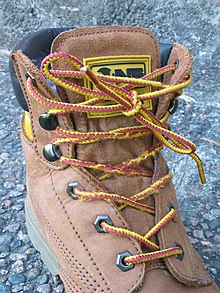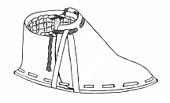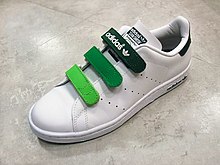Shoelaces

The lace , braid , laces , shoelaces , Schuhnestel , Schuhbanderl or shoelaces (Switzerland, Baden-Württemberg, Pfalz, Vorarlberg, Franconia) or shoelaces (Austria) are bands or cords that are used to shoes with laces to close to to ensure their hold on the foot.
Origin of the word Senkel
The word "Senkel" is a noun formation from the verb "lower" ("bring to sink") and originally referred to an anchor (ahd. "Senkil" anchor). From this the meaning of “ plumb bob ” was derived, with which one could draw a “vertical” line.
From this the expression “put in the lace” with the meaning “to align something”, “to get on the right path”, “to bring it into shape” arose.
The term “shoelaces” came about through a detour via clothing fashions that z. B. provided belts with hanging cords and pompons. In the past, a piece of metal was often attached to the end of these shoelaces, such as B. the plumb bob. The shoelaces were and still are partly provided with additional jewelry (mainly hanging from high lace-up boots).
(Compare, for example, the expression "walk or step on someone".)
Historical
It is not known exactly when the first shoelaces appeared. The ice mummy " Ötzi " found in the Alps already wore shoes that were closed with a kind of shoelace (leather strap).
Shoes locked with straps were already common in the Middle Ages . The lace - up shoes or lace - up boots made using turning technology and thus called turning shoes were closed with straps made of leather or textile, the so-called Nestelband . Alternatively, they were closed with button straps or buckles . The ribbon, which was also called laces back then, was also used as an ornament or to close clothing .
Types and materials
Shoelaces are mainly differentiated according to their appearance (flat laces and round laces), production method (woven, braided or knitted) and material ( cotton , synthetic fibers or mixtures, rarely leather straps ). In addition, there are other distinguishing features, such as the type of coloration, the presence of a luster (so-called "waxed lace") and whether it is fine or coarse lace. Very wide, often colorful, hip-hop fashion laces are called fat laces .
The lace ends called "needles" are either welded together to form a "pin" (only possible with synthetic fiber laces), sealed with a plastic film ("needles" or "pins") or provided with a metal cap made from lace plate. This prevents fraying and ensures problem-free threading. In vernacular, the metal end of a shoelace is also called “pink”. There is also the so-called lace curtain (tassels, pompons) for decoration. In the past, washed-off celluloid sheets from old films were often used as plastic sheets . Cellulose acetate film is mostly used today.
Recently, needles are welded using ultrasound using needling machines.
Ways of attachment

Shoelaces have an impact on the overall appearance of the shoe through the type and sequence in which they are threaded through the eyelets . Cross-lacing (for sporty shoes, model type Derby) and parallel lacing (for elegant shoes, model type Oxford) connect both sides of the shoe most strongly. Combination lacing is shorter but less firm. The safest way to tie the ligaments is with the square knot , the surgeon's knot or, faster, with the ankle knot . However, almost half of the people make the unsafe old woman's knot , which can be recognized by the oblique or vertical loops. Often the old woman's knot is tied over with another overhand knot or placed below the shoe tongue ( flap ) to prevent it from opening. Many young people tie their shoelaces below the tongue for fashion reasons, as the bow cannot be seen. Young people also often tuck their shoelaces into the side of the shoe without tying them in order to enable the shoe to be used as a slipper . Some cyclists tie the knot on the outside of the shoe to prevent the loops from getting caught in the chain. The Ashley book of knots also shows different ways of tying from # 2033 to # 2039, for example.
Length of the laces
The length of the shoelaces required for a certain pair of shoes is primarily dependent on the number of pairs of shoelace holes, but can also vary (wide lacing, narrow lacing, use of hooks instead of eyes, etc.). The following table is a guide:
| Pairs of holes | Length (in cm) |
|---|---|
| 2 | 45 |
| 3 | 45 or 60 |
| 4th | 60 |
| 5 | 75 |
| 6th | 90 or 100 |
| 8th | 120 or 150 |
| 10 | 180 |
The rule of thumb for the length of the shoelace is: 10 * individual holes - 10
Colors of shoelaces

The lace color contributes greatly to the overall appearance of the shoe. In the case of classic leather low shoes, the lace color is slightly darker than the leather color. Black leather shoes have black laces. Deviations from these basic rules can be found in fashionable leather shoes. Sports and hiking shoes also allow other lace colors.
Some social groups (e.g. punks or skinheads ) sometimes attribute a political meaning to the colors of shoelaces , which can, however, be interpreted differently from region to region. A well-known example is wearing white laces in Doc Martens or steel toe boots : Depending on the interpretation, this combination should be an expression of a racist sentiment or a sign of the unity of blacks and whites.
Alternatives
There are various solutions to bypass or simplify tying the shoelaces.
- Twisted shoelaces (“Spyrolaces”, “NO-TIE-LACES” or “spiral laces”) from the USA were developed to help people who find it difficult to tie: Pulling at both ends is enough to keep the lacing to tighten.
- Elastic laces. In addition to these twisted shoelaces, simple elastic shoelaces can also be used. After tying the shoes once, they can simply be put on with the shoehorn without having to tie the laces again. Another possibility is the use of cord stoppers , with which the laces are simply pulled shut. This eliminates the tedious stooping when putting on the shoes for some.
- Velcro fastener
- Buckles (technically: pin buckles) on sandals , ski boots
- Click buckles
- Zippers on the tongue that are laced on the left and right; Often used in firefighting, police and military boots to make it easier and faster to put the boots on
Related topics
- The bolo tie or shoelace tie is part of western fashion.
Individual evidence
- ↑ http://www.etymologie.info/~e/d_/de-arbeit.html#Schn%C3%BCrsenkel
- ↑ Senkelblech - Grammatical-Critical Dictionary of High German Dialect. In: Adelung: 1793, Volume 4.Page 57 , accessed on January 24, 2010 .
- ^ Jacob and Wilhelm Grimm : German Dictionary . Volume 13, p. 1860
- ↑ Burkard Polster: What is the best way to lace your shoes? In: Nature . Volume 420, N ° 6915, 2002, page 476.
- ^ Ian Knot = Ian's Fast Shoelace Knot. Retrieved January 1, 2012 .
- ↑ Hiking Lacing / Biking Lacing. Retrieved January 1, 2012 .
literature
- Burkard Polster: The Shoelace Book: A Mathematical Guide to the Best (And Worst) Ways to Lace Your Shoes. Mathematical World, 2006, ISBN 0-8218-3933-0 (English).
- Helge Sternke: Everything about men's shoes. Nicolai, Berlin 2006, ISBN 3-89479-252-3 (with its own section on shoelaces).
- Ian Fieggen: Laces: 100s of Ways to Pimp Your Kicks. Sterling, New York, NY 2007, ISBN 978-1-4027-5201-8 (English).






